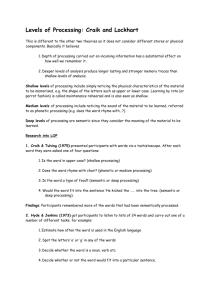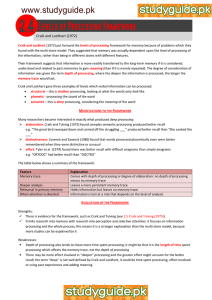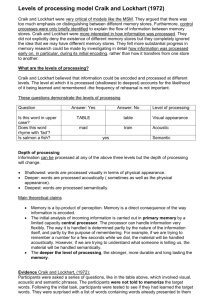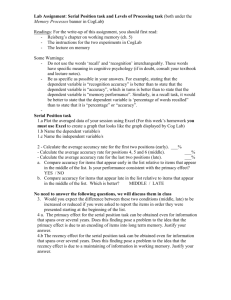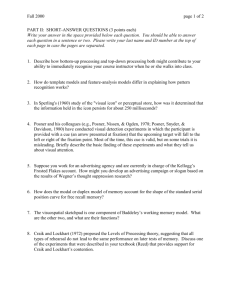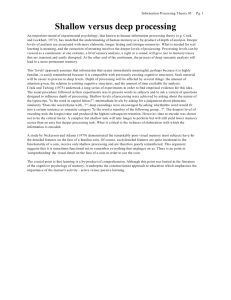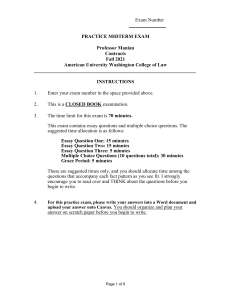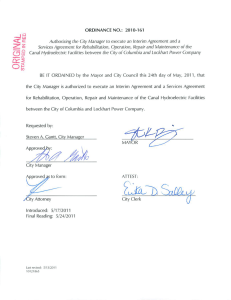Project Memory: Making It Work!
advertisement
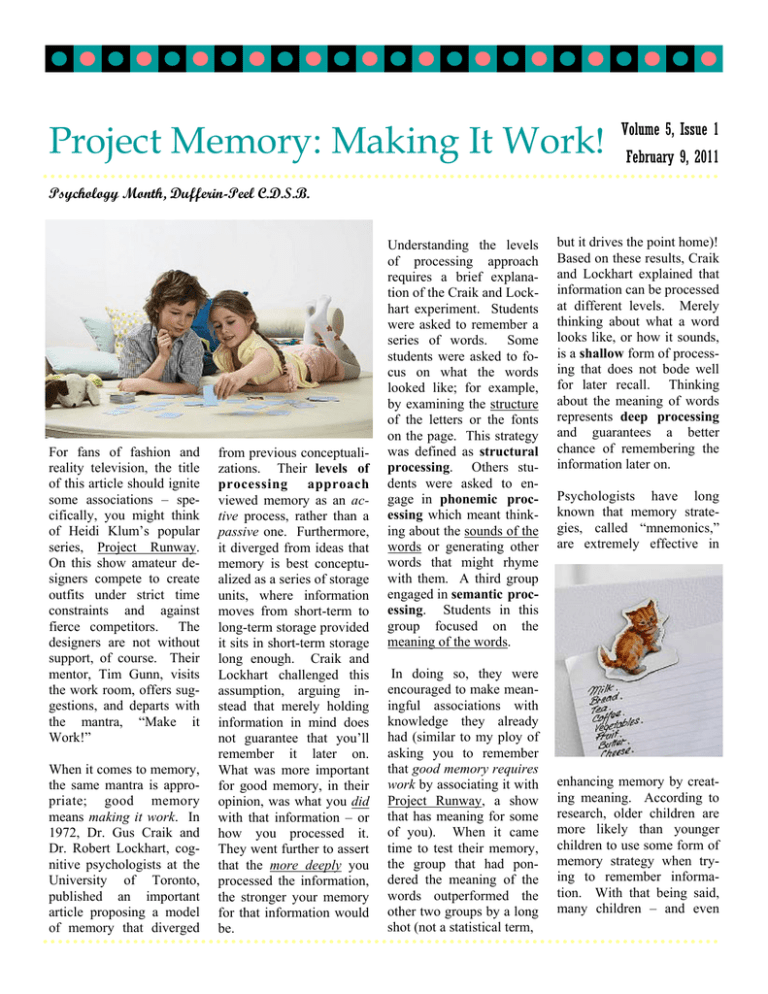
Project Memory: Making It Work! Volume 5, Issue 1 February 9, 2011 Psychology Month, Dufferin-Peel C.D.S.B. For fans of fashion and reality television, the title of this article should ignite some associations – specifically, you might think of Heidi Klum’s popular series, Project Runway. On this show amateur designers compete to create outfits under strict time constraints and against fierce competitors. The designers are not without support, of course. Their mentor, Tim Gunn, visits the work room, offers suggestions, and departs with the mantra, “Make it Work!” When it comes to memory, the same mantra is appropriate; good memory means making it work. In 1972, Dr. Gus Craik and Dr. Robert Lockhart, cognitive psychologists at the University of Toronto, published an important article proposing a model of memory that diverged from previous conceptualizations. Their levels of processing approach viewed memory as an active process, rather than a passive one. Furthermore, it diverged from ideas that memory is best conceptualized as a series of storage units, where information moves from short-term to long-term storage provided it sits in short-term storage long enough. Craik and Lockhart challenged this assumption, arguing instead that merely holding information in mind does not guarantee that you’ll remember it later on. What was more important for good memory, in their opinion, was what you did with that information – or how you processed it. They went further to assert that the more deeply you processed the information, the stronger your memory for that information would be. Understanding the levels of processing approach requires a brief explanation of the Craik and Lockhart experiment. Students were asked to remember a series of words. Some students were asked to focus on what the words looked like; for example, by examining the structure of the letters or the fonts on the page. This strategy was defined as structural processing. Others students were asked to engage in phonemic processing which meant thinking about the sounds of the words or generating other words that might rhyme with them. A third group engaged in semantic processing. Students in this group focused on the meaning of the words. In doing so, they were encouraged to make meaningful associations with knowledge they already had (similar to my ploy of asking you to remember that good memory requires work by associating it with Project Runway, a show that has meaning for some of you). When it came time to test their memory, the group that had pondered the meaning of the words outperformed the other two groups by a long shot (not a statistical term, but it drives the point home)! Based on these results, Craik and Lockhart explained that information can be processed at different levels. Merely thinking about what a word looks like, or how it sounds, is a shallow form of processing that does not bode well for later recall. Thinking about the meaning of words represents deep processing and guarantees a better chance of remembering the information later on. Psychologists have long known that memory strategies, called “mnemonics,” are extremely effective in enhancing memory by creating meaning. According to research, older children are more likely than younger children to use some form of memory strategy when trying to remember information. With that being said, many children – and even 2 adults – fail to use effective strategies. For example, many students study by reading material over and over again; this approach, called maintenance rehearsal, is ineffective for recalling information over time. Simply reading, or repeating something, over and over is akin to shallow processing. For deep processing you must engage in elaborative rehearsal; you must work with the material, and create meaning. For example, while writing a grocery list, try committing the items to memory in a meaningful way. To remember eggs, milk, diapers, and hairspray, visualize a dairy cow in diapers, wearing a pink wig, and dancing with a chicken. The more meaningful, distinctive, and humorous your image, the more likely you’ll remember it. Test your memory by consulting the grocery list (if you remembered to bring it!) after you have retrieved the items from the shelves. Fortunately, most children and adults can be taught to use effective memory strategies with explicit instruction. If you are a teacher, why not try a memory exercise in class and put the levels of processing theory to the test? Devise a list of 20 items. For example, you might use mouse, pail, boat, elephant, cloud, hat, balloon, book, ant, sun, pyramid, phone, cake, chair, kettle, shoe, car, bowl, spoon and camera. Ask your students to write the numbers 1 to 20 on a blank piece of paper, and then to put their pencils down. Explain that they must try to remember as many words as they can. Now read the list aloud – delivering words fairly quickly with only a few seconds between them. When you have finished reading, ask your students to write as many words as they can remember. After about a minute or two – when your students are sure they cannot remember anything more – read the list out loud again and ask each student to calculate their score out of 20. If your students are relying largely on maintenance rehearsal – by repeating the words in their head – they will remember the first few items the best. They’ll also remember the last few items – since you just said them – but they’ll probably forget most of the items in between. For the second part of the exercise, work collaboratively with the class to create meaningful images. Appoint either yourself or an artist in the class to draw on the board, and start reading the list again. For example, you might draw a mouse, and then draw that mouse sitting in a pail. The next word is boat, so you could draw a boat around that mouse in the pail – and that boat could be steered by the elephant which is next on the list and, well, you get the idea…Once the picture is complete, give your students a minute or two to study it. Then erase or cover the picture. Now ask your students, on a blank piece of paper (so they cannot see the words they wrote previously), to write as many words as they can remember. If the levels of processing theory holds true, then your students’ scores should improve dramatically! For an elaborate and meaningful discussion of more mnemonic strategies, speak with your psychology staff member. Have fun with your memory – and be sure to “Make it Work!” For further information contact your school psychology staff or Dr. Debra Lean, Chief Psychologist. You can access this or other interesting articles at: http://w3.dpcdsb.org/CEC/Programs/Special+Education/ Support+Services/PSY/Resources.htm Craik, F. & Lockhart, R. (1972). Levels of processing. A framework for memory research. Journal of Verbal Learning and Verbal Behaviour, 11, 671-684.
